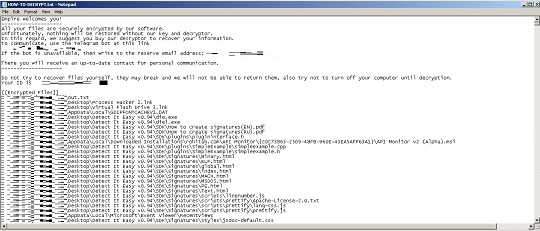Ransom.Win32.EMPIRE.THAOBBD
Windows


Threat Type: Ransomware
Destructiveness: No
Encrypted:
In the wild: Yes
OVERVIEW
Downloaded from the Internet, Dropped by other malware
This Ransomware arrives on a system as a file dropped by other malware or as a file downloaded unknowingly by users when visiting malicious sites.
It encrypts files with specific file extensions. It encrypts files found in specific folders. It drops files as ransom note.
TECHNICAL DETAILS
204,625 bytes
EXE
No
02 Jan 2024
Encrypts files, Modifies system registry
Arrival Details
This Ransomware arrives on a system as a file dropped by other malware or as a file downloaded unknowingly by users when visiting malicious sites.
Installation
This Ransomware adds the following processes:
- Notepad %Desktop%\HOW-TO-DECRYPT.txt
- "vssadmin.exe" delete shadows /all /quiet
- "Wbadmin.exe" DELETE SYSTEMSTATEBACKUP
- "Wbadmin.exe" DELETE SYSTEMSTATEBACKUP -deleteOldest
- "cmd.exe" /c vssadmin delete shadows /all /quiet
- Cmd.exe /c wmic shadowcopy delete
- Cmd.exe /c bcdedit /set {default} bootstatuspolicy ignoreallfailures
- Cmd.exe /c bcdedit /set {default} recoveryenabled no
- Cmd.exe /c wbadmin delete catalog -quiet
- Cmd.exe /C choice /C Y /N /D Y /T 1 & Del {Malware File Path}
(Note: %Desktop% is the current user's desktop, which is usually C:\Documents and Settings\{User Name}\Desktop on Windows 2000(32-bit), XP, and Server 2003(32-bit), or C:\Users\{user name}\Desktop on Windows Vista, 7, 8, 8.1, 2008(64-bit), 2012(64-bit) and 10(64-bit).)
It adds the following mutexes to ensure that only one of its copies runs at any one time:
- ntyUBXFQTHyHkrn
Other System Modifications
This Ransomware adds the following registry entries:
HKEY_CURRENT_USER\Software\Microsoft\
Windows\CurrentVersion\Policies\
System
DisableRegistryTools = 1
HKEY_CURRENT_USER\Software\Microsoft\
Windows\CurrentVersion\Policies\
System
DisableTaskMgr = 1
Other Details
This Ransomware adds the following registry keys:
HKEY_CURRENT_USER\Software\Microsoft\
Windows\CurrentVersion\Policies\
System
It does the following:
- After its encryption, it display its ransom note
- Delete System Restore point
- Terminates itself if mutex is not created
- Connects to the following URL to send Keys(Password, Hwid, Salt):
- https://{BLOCKED}54.xsph.ru/one.php
- It also encrypt removable and fixed drives
Ransomware Routine
This Ransomware encrypts files with the following extensions:
- .txt
- .TXT
- .jar
- .exe
- .dat
- .contact
- .settings
- .doc
- .docx
- .xls
- .xlsx
- .ppt
- .pptx
- .odt
- .jpg
- .png
- .jpeg
- .gif
- .csv
- .py
- .sql
- .mdb
- .sln
- .php
- .asp
- .aspx
- .html
- .htm
- .css
- .md
- .rtf
- .yaml
- .conf
- .json5
- .xml
- .psd
- .dll
- .c
- .cs
- .vb
- .vbs
- .p12
- .mp3
- .mp4
- .f3d
- .dwg
- .cpp
- .h
- .chm
- .chw
- .msi
- .zip
- .rar
- .mov
- .rtf
- .bmp
- .mkv
- .avi
- .apk
- .lnk
- .iso
- .7z
- .ace
- .arj
- .bz2
- .cab
- .gzip
- .gz
- .tgz
- .tar.gz
- .tbz2
- .tar.bz2
- .txz
- .tar.xz
- .bkf
- .tar.zip
- .tar.7z
- .tib
- .gho
- .bak
- .ab
- .vbk
- .scr
- .fbl
- .dmp
- .tmp
- .wps
- .com
- .bat
- .cmd
- .msp
- .cpl
- .ps1
- .vbs
- .js
- .wsf
- .cmdx
- .lzh
- .tar
- .uue
- .xz
- .z
- .001
- .mpeg
- .mp3
- .mpg
- .core
- .crproj
- .pdb
- .ico
- .pas
- .db
- .torrent
- .sqlite
- .mysql
- .dbf
- .json
- .postgresql
- .oracle
- .nosql
- .wim
- .cur
- .sdb
- .xsd
- .mui
- .log
- .rsm
It encrypts files found in the following folders:
- %User Profile%
(Note: %User Profile% is the current user's profile folder, which is usually C:\Documents and Settings\{user name} on Windows 2000(32-bit), XP, and Server 2003(32-bit), or C:\Users\{user name} on Windows Vista, 7, 8, 8.1, 2008(64-bit), 2012(64-bit) and 10(64-bit).)
It drops the following file(s) as ransom note:
- %Desktop%\HOW-TO-DECRYPT.txt

SOLUTION
9.800
18.916.03
02 Jan 2024
18.917.00
03 Jan 2024
Step 1
Trend Micro Predictive Machine Learning detects and blocks malware at the first sign of its existence, before it executes on your system. When enabled, your Trend Micro product detects this malware under the following machine learning name:
-
TROJ.Win32.TRX.XXPE50FFF075
Step 2
Before doing any scans, Windows 7, Windows 8, Windows 8.1, and Windows 10 users must disable System Restore to allow full scanning of their computers.
Step 3
Note that not all files, folders, and registry keys and entries are installed on your computer during this malware's/spyware's/grayware's execution. This may be due to incomplete installation or other operating system conditions. If you do not find the same files/folders/registry information, please proceed to the next step.
Step 4
Search and delete these files
- %Desktop%\HOW-TO-DECRYPT.txt
Step 5
Delete this registry key
Important: Editing the Windows Registry incorrectly can lead to irreversible system malfunction. Please do this step only if you know how or you can ask assistance from your system administrator. Else, check this Microsoft article first before modifying your computer's registry.
- In HKEY_CURRENT_USER\Software\Microsoft\Windows\CurrentVersion\Policies\System
Step 6
Delete this registry value
Important: Editing the Windows Registry incorrectly can lead to irreversible system malfunction. Please do this step only if you know how or you can ask assistance from your system administrator. Else, check this Microsoft article first before modifying your computer's registry.
- In HKEY_CURRENT_USER\Software\Microsoft\Windows\CurrentVersion\Policies\System
- DisableRegistryTools=1
- DisableRegistryTools=1
- In HKEY_CURRENT_USER\Software\Microsoft\Windows\CurrentVersion\Policies\System
- DisableTaskMgr=1
- DisableTaskMgr=1
Step 7
Scan your computer with your Trend Micro product to delete files detected as Ransom.Win32.EMPIRE.THAOBBD. If the detected files have already been cleaned, deleted, or quarantined by your Trend Micro product, no further step is required. You may opt to simply delete the quarantined files. Please check the following Trend Micro Support pages for more information:
Did this description help? Tell us how we did.

